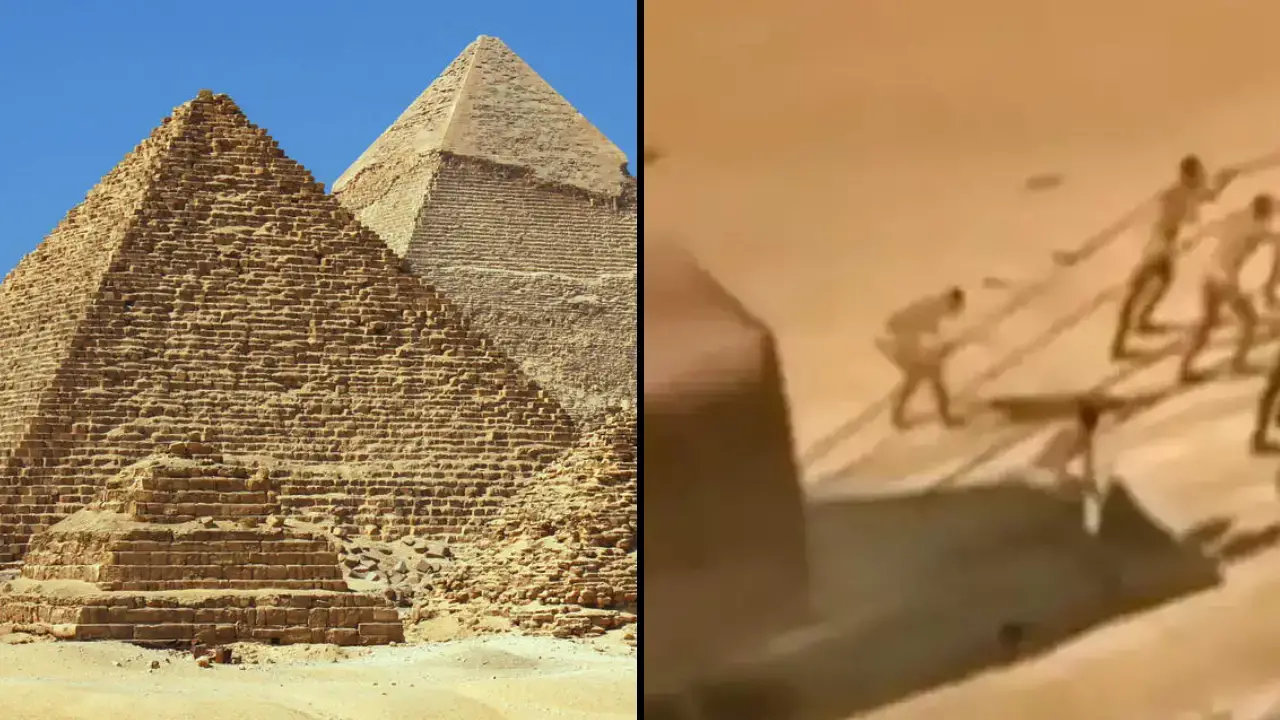
Credit: Alamy & Ancient Finds via YouTube
One of Earth’s Great Mysteries Of How The Egyptians Moved The Pyramid Stones Has Been Solved
Unravelling the ancient mystery of how the Egyptians constructed the awe-inspiring pyramids at Giza has long captivated historians and archaeologists.
The Great Pyramid comprises an astonishing 2.3 million limestone and granite blocks, each weighing no less than two tons.
With its construction initiated around 4,500 years ago, the methods behind this architectural marvel have remained an enigma.
Yet a team of researchers now proposes a remarkable theory that may hold the key.
Related Article: Scientist ‘Worked Out’ Extraterrestrial Signal Sent To Earth In 1977
Related Article: Couple Claiming To Be Time Travellers From 2027 Share Footage ‘Proving They’re All Alone’
Contrary to fanciful theories involving extraterrestrial intervention, a recent discovery suggests that the ingenious Egyptians utilised their environment to transport colossal stone slabs, shedding light on their remarkable engineering prowess.
Rather than relying on speculative notions, these historians assert that the ancient civilisation harnessed the power of a Nile tributary to move the massive stone blocks across the desert.
A tributary is a river or stream that flows into a larger river or lake.
This hypothesis is supported by extensive research involving fossilised soil samples extracted from the Giza floodplain.
Analysed for traces of pollen and vegetation commonly associated with the Nile’s surroundings, these samples confirmed the existence of an ancient waterway, the Khufu Branch.
To ascertain the theory’s validity, archaeologists delved as deep as 30 feet into the earth to retrieve these samples, uncovering millennia of Egyptian history in the process.
Their efforts revealed that the Khufu Branch once facilitated the transport of stone slabs to their eventual resting place within the pyramids, a feat that would have been near impossible without this tributary’s assistance.
The study further identified 61 plant species, deepening the understanding of the environment at the time.

This revelation was not accidental; it emerged from a fragment of papyrus discovered in the Red Sea.
The ancient document recounted the journey of an official named ‘Merer’, tasked with transporting limestone along the Nile to the construction site at Giza.
This historical record corroborated the recent findings, confirming that waterways played a pivotal role in the pyramid-building process.
Although the waterway itself may have vanished over the aeons, the implications of this discovery is profound.
Beyond resolving the enigma of stone transportation, this revelation may pave the way for understanding how these remarkable structures were raised.
The environment’s impact on construction techniques and the ingenious adaptations employed by the ancient Egyptians hold the promise of unveiling further secrets.
Related Article: People Are Convinced There’s A ‘Glitch In The Matrix’ After Plane Spotted Not Moving In Sky
Related Article: Unbelievable Video Captured From Plane Is Being Called ‘Best UFO Footage Ever’
Hader Sheisha, an environmental geographer involved in the research, told The New York Times that comprehending the pyramid-building environment is key to solving the broader puzzle.
She said: “Knowing more about the environment can solve part of the enigma of the pyramids’ construction.”
As the secrets of the Nile’s role in the pyramids’ construction are gradually unearthed, a clearer picture of the ancient civilization’s remarkable achievements is beginning to emerge.
The story of the Giza pyramids, it seems, is far from over.
With every discovery, the veil of mystery surrounding these awe-inspiring monuments is gradually lifted, allowing modern observers to gain deeper insights into the ingenious techniques employed by the ancient Egyptians.
The legacy of these remarkable structures continues to captivate, inspire, and teach us about the ingenuity of the past.